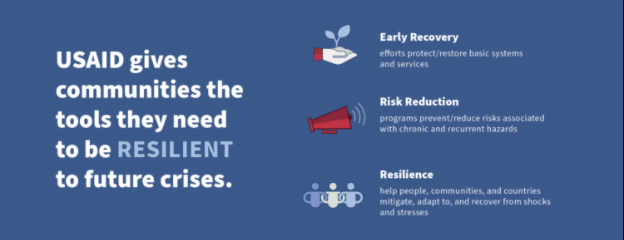<< Back to Media
Disaster Preparedness and the Bureau for Humanitarian Assistance
September 28, 2021
National Preparedness Month is observed each September in the United States with the intention of raising awareness of the importance of family and community preparedness. This year’s theme is “Prepare to Protect. Preparing for disasters is protecting everyone you love.” In the midst of the COVID-19 pandemic and humanitarian crises in Haiti and Afghanistan, disaster preparedness is more important than ever to ensure the health and safety of loved ones. USAID’s Bureau for Humanitarian Assistance prepares to protect daily, aiming to foster a culture of preparedness globally.
Disaster Preparedness at USAID
As the lead federal coordinator for international disaster assistance, the BHA recognizes the importance of proactively taking steps to mitigate the effects of future disasters. . Early Recovery, Risk Reduction, and Resilience (ER4), BHA’s foundation for disaster relief, is implemented through local, national, and regional level programs intended to “[address] chronic vulnerabilities and [reduce] the overall impact of recurrent shocks and stresses.” ER4 programs differ across the world to accurately and effectively provide aid to each country’s specific geographic, environmental, and political stressors. Due to the unique risks faced by each country and region, programs take on countless forms from supporting the development of supply chain management systems to respond to disasters more effectively to teaching sustainable agricultural practices. Generally, ER4 programs seek to do the following:
Early Recovery efforts intend to protect or restore basic systems and services during and immediately after a disaster. Early recovery is a strategy that lays the foundations for recovery and growth in alignment with development priorities and principles.
Risk reduction aims to prevent or reduce risks associated with chronic and recurrent hazards of all forms. This strategy emphasizes local response preparedness, emergency management systems, and early warning systems.
Resilience programs address the root causes of disaster while building capacity and resources to help communities mitigate, adapt to, and recover from crisis.

ER4 in Action
. These efforts are carried out through a vast network of partnerships with nonprofits, think tanks, government agencies, and multilateral organizations. A large portion of BHA’s ER4 programming focuses on enhancing individual and local capacity and resilience to reduce chronic vulnerability. Activities include:
- Building and maintaining intra and intergovernmental networks of rapid response personnel and training first responders through the Regional Disaster Assistance Program in the Latin America & Caribbean region
- Working with the United Nations World Food Programme to enhance emergency telecommunication and relief supply chain capabilities in the Caribbean, building the operational capacity of the Caribbean Disaster Emergency Management Agency
- Mainstreaming gender and disability inclusion in community-based risk management in Samoa and Toga with CARE by working with local nonprofits to expand knowledge of the risks for different groups in the face of natural disaster
- Strengthening information management for Afghan emergency preparedness with a NGO partner and local humanitarian organizations, community leaders, and government officials to develop hazard maps and accessible resources.
- Partnering with a coalition of NGOs led by Mercy Corps to improve food security in the Democratic Republic of the Congo to enhance resiliency by providing resources to households, rebuilding roads and infrastructure, training individuals in water management, improving water access, and teaching sustainable agricultural practices.
- Providing a grant to the Philippine Disaster Resilience Foundation to strengthen collaboration between the government and private sector in disaster preparedness; working with the community, local organizations, and NGOs, common risks were identified and shared mitigation plans and strategies were developed, as well as continuity planning to protect infrastructure and community services in cities.
Public- Private Partnerships
With the rising frequency and severity of global catastrophes, USAID funding and resources are spread thin. To combat resource shortages, USAID works with private entities, known as Private Sector Engagement (PSE) to find solutions. PSE is defined as
“a strategic approach to planning and programming through which USAID consults, strategizes, aligns, collaborates, and implements with the private sector for greater scale, sustainability, and effectiveness of development or humanitarian outcomes,” according to USAID’s Private Sector Engagement Policy.
An example of successful PSE with USAID was in the Philippines during a water and sanitation crisis. As USAID’s PSE Policy expands, BHA is looking more towards the private sector to provide funding, expertise, technology, and local or regional knowledge needed to best prepare for natural and man-made disasters.
WBD’s Role
Washington Business Dynamics has worked alongside USAID and the BHA to implement the Private Sector Engagement (PSE) policy and develop critical capacity building tools to enable development professionals to identify, approach, negotiate, and work with private sector partners. WBD is currently leading a PSE Working Group with representatives from each BHA office to discuss how PSE may be integrated into all aspects of BHA’s program cycle; this has resulted in the creation of an Implementation Plan for the Agency articulating activities and approaches for successful PSE. WBD is proud to support BHA in its efforts to enhance the recovery and resilience of communities worldwide.
Author: Brittany Shore, Associate at WBD, is an international development and humanitarian professional engaged with the firm’s Private Sector Engagement Support award with the United States Agency for International Development.
